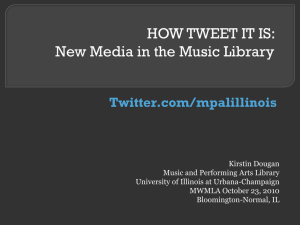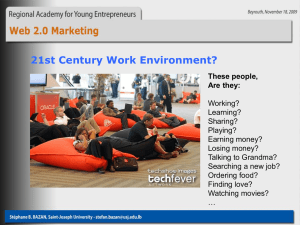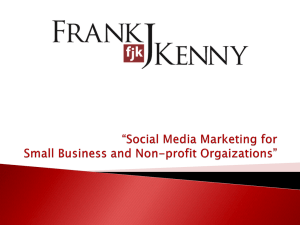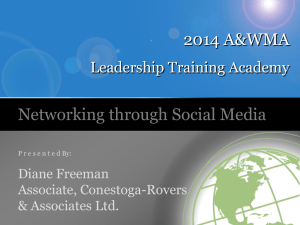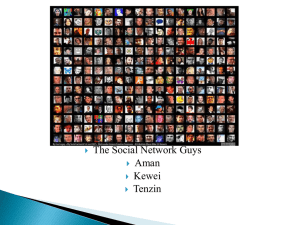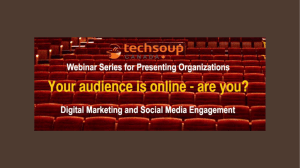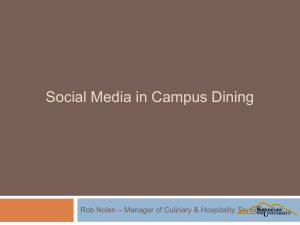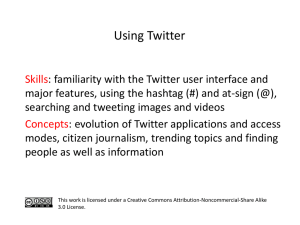Social Media for Social Justice Training Guide
advertisement
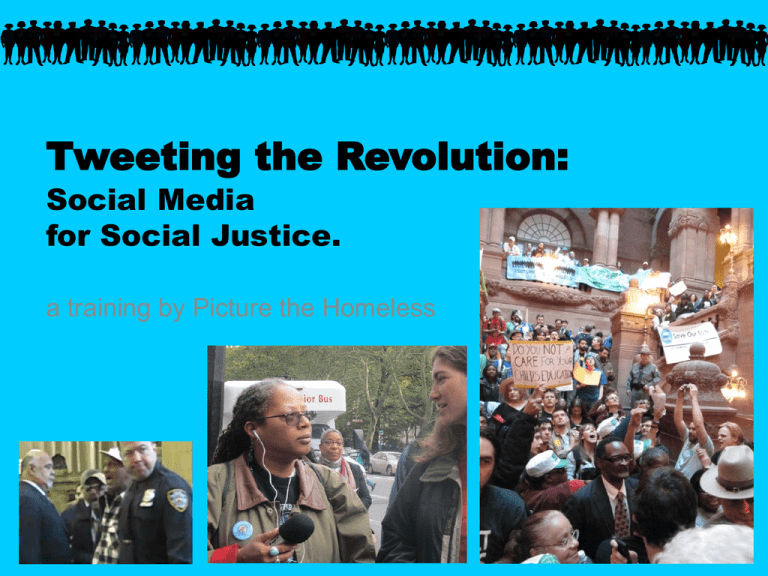
Tweeting the Revolution: Social Media for Social Justice. a training by Picture the Homeless Social Media for Social Justice: TRAINING OUTLINE 1. Overview: What's So Social about Social Media? 2. The 6 Fundamentals of Social Media 3. What the F is Facebook? What the F is Twitter? YouTube? 4. Examples! 5. Tips and Tricks for Using Social Networking in Organizing 6. What Do You Need to Get Started? 7. Questions and Answers Social Media for Social Justice: OVERVIEW What's so SOCIAL about SOCIAL MEDIA? Social media sites are built on people sharing their lives and interests with other people. Hundreds of millions of people use them every day. Baby pictures, graduation videos, gossip, opinions about politics or pop music – people put all of that and more onto the internet for their friends and family (and total strangers) to see and comment on. Social Media for Social Justice: OVERVIEW What makes it different? Media on the internet initially followed the same model as oldschool TV and print and radio. Outlets communicated information to a general audience. It was a one-way conversation. Social media is fundamentally a dialogue between a smaller audience of people with common interests. Social media allows people to comment on and critique and share perspectives. Some call it “Web 2.0” to underscore how different it is from the old-school, one-way internet. Social Media for Social Justice: OVERVIEW What's the connection between social media and social justice? Many of the principles are similar to community organizing. It's about people coming together for a common purpose, building a community of people who care about the same things. Most of the time, this doesn't go any further than silly conversation about celebrities and sports, but it's up to us to turn those connections and conversations into action. Social Media for Social Justice: OVERVIEW The bottom line is: Thanks to social networking technology, we're no longer at the mercy of the mainstream media. When we want to tell our side of the story, we don't have to beg the New York Times to cover it―and then feel bad because they don't. We can tell our stories, ourselves, and put it out into the world for everyone to see. Social Media for Social Justice: FUNDAMENTALS 1. IT'S JUST MORE WORK. Social media is not some magic bullet that will do the work for us. No matter how much the mainstream media talks about Egypt as a “Facebook Revolution,” we know that their revolution came about the same way ours will: through the hard work of committed amazing organizers. A Twitter update doesn't get you off the hook of phone-banking or doorknocking, just like an email is no substitute for a real conversation. Social Media for Social Justice: FUNDAMENTALS 2. IT'S NOT SEPARATE! SOCIAL MEDIA IS PART OF THE ORGANIZING. Social media doesn't work when it's someone in an office somewhere with no idea what's happening on the ground. It's another venue for the voices of directly-affected communities to be heard, and as such should be incorporated into all other facets of good organizing (leadership development, direct action, public education, participatory research, etc). Social Media for Social Justice: FUNDAMENTALS 3. IT'S A ROLE LIKE ANY OTHER. If you're going to take social media seriously, take it as seriously as police negotiator or press caller or any other role. One specific person should take on the responsibility of all your social media accounts whenever there's a direct action or other event, and do so in open participation with other action components. Social Media for Social Justice: FUNDAMENTALS 4. EVERYONE CAN PARTICIPATE – REGARDLESS OF THEIR TECHNOLOGY COMFORT LEVEL. One great plus of social media is the way good organizing can open it up to everyone. If a member is too nervous about public speaking to be the spokesperson at a press conference, you can chat with them one-on-one in the office and shoot a short video for YouTube. Folks with Facebook accounts can invite friends and family to actions. We'll go into more specific examples a little later. Social Media for Social Justice: FUNDAMENTALS 5. IT'S A TOOL LIKE ANY OTHER – IT'S ONLY AS GOOD OR AS BAD OR AS STUPID AS THE USE YOU PUT IT TO. Maybe 95% of what goes on on Facebook is a stupid and ridiculous waste of time. Maybe most people follow Twitter so they can find out what Paris Hilton had for breakfast. But WE can use it to do turnout for a protest, or to cry foul on a bad news story, or a million other positive things. So while we might personally find these things ridiculous, we can't afford to overlook any tools in the struggle for liberation. Social Media for Social Justice: FUNDAMENTALS 6. ALL THE SAME RULES APPLY. The enemy is listening. Anything you put out on an open social network WILL be read by law enforcement or other targets. Don't put out sensitive information! Also: * DON'T say anything you don't want repeated, * DON'T talk sh*t (unless it's about your targets), * DON'T lie... Social Media for Social Justice: What the F is Facebook? Facebook is a social networking website with more than 500 million active users - about one person for every fourteen in the world. Users can add people as friends and send them messages, and update their personal profiles to notify friends about themselves. Additionally, users can join networks organized by workplace, school, or college. Other social networking sites include MySpace.com, Friendster.com, and LinkedIn.com, but Facebook has way more users than any of them. Social Media for Social Justice: What the F is Twitter? Twitter is a social media site that allows users to share short, 140-character updates – called “tweets” - about what they're doing. They can include links and pictures and video. Example: “New Yorkers Camp Out to Protest Bloomberg Budget Cuts: http://t.co/SXtNrpN” Twitter currently has over 100 million users! Facebooking Direct Action A Checklist for Using Facebook to Support an Action. 1. Create an “Event” AT LEAST 2 WEEKS BEFORE 2. Invite all your friends WHEN CREATING EVENT 3. Send reminders A WEEK BEFORE AND A DAY BEFORE 4. Post all your photos, tag friends who attended, post links to any press coverage THE DAY AFTER Putting YouTube to Work for You For radical organizing purposes, the best YouTube videos are: 1. SHORT 2. SIMPLE/STRAIGHTFORWARD 3. FEATURE THE VOICES OF DIRECTLYIMPACTED LEADERS 4. SEXY (in the sense of: attention-grabbing, provocative, exciting... not boring and talky!) YouTube in Action Anthony is a young leader at FUREE (Families United for Racial and Economic Equality), one of our favoritest allies. Here he breaks down - IN NINE SECONDS! why we're going to Albany... YouTube in Action YouTube can also be useful for longer, more indepth videos! Here's a thirteen-minute film we shot and edited together “Sometimes the Choir Needs to Be Preached To” (for viewing on your own time!) Tweeting the Revolution You can be silly and have fun on Twitter: “FIERCE ate an amazing meal & r bout 2 dig into chocolate cake! thanks 2 Alan Gail & staff @Manny's!” FIERCE (NYC lgbtq youth organizers) You can drop random knowledge: “Ng'ethe Maina: it's not simply enough to fight for the liberation of our society, we have to fight for the liberation of ourselves” - @CAAAV – Organizing Asian Communities Tweeting the Revolution You can break a news story on Twitter: “The weather's getting nice and the police are out enforcing laws that don't serve or protect. Buddhist nun arrested: http://t.co/hUGZl6q“ (CAAAV again) You can steer people towards longer pieces: “GGJ STATEMENT ON THE 2nd ANNIVERSARY OF THE COUP IN HONDURAS STOP US MILITARY AID TO THE COUP REGIME http://t.co/8V4CJzi” (Grassroots Global Justice, national alliance of basebuilding groups) Tweeting the Revolution YOU CAN USE TWITTER TO GIVE UPDATES DIRECTLY TO YOUR MEMBERS: “ALP Office will be CLOSED today!” - (Audre Lorde Project, organizing center for LGBTQ people of color) OR TO SEND A MESSAGE TO A TARGET: “@domenicrecchia [powerful, conservative City Council Member] - Coney Island can't take the cuts!!!! Support the PEOPLE'S Budget!” - (Beyond May 12, unioncommunity coalition against budget cuts) Building a Base – On Twitter Twitter's just like real life: you need to build a base. Here are some tips. 1. Twitter OFTEN, even if it's stupid sh*t. 2. Search out and “Follow” lots of other Twitterers – many of them will return the favor. These can include: grassroots orgs, reporters, media outlets, politicians... 3. Be consistent: spend time on it regularly, even if it's just five minutes every other day. 4. Retweet stuff from your allies, even if it's stupid sh*t. 5. Don't take it too seriously. Social Media for Social Justice SECRETS OF TWITTER: HASHTAGS A hashtag is just a number sign. Like this: # - But when you put it next to a word, it becomes a hashtag: #nycoccupation – and people who want to follow a specific issue or event can just search for #nycoccupation, and get all the latest news. We used the hashtag #bloombergville for our tent city protest at City Hall, and dozens of people picked it up and started , so that we could share information, emergency alerts, etc. By creating a specific hashtag for an action or campaign, you make it easy for people to share information about it. We've used #Count2011 for our vacant property count, #nycoccupation for our vacant lot takeover, etc. Secrets of Twitter: Retweets! A retweet (or RT) is when you take something that someone else said, and pass it on to your followers. For social justice twitterers, it's a tiny little act of solidarity – helping spread the word about what they're doing. Social Media for Social Justice: TIPS AND TRICKS 1. EXPLOIT JOURNALIST LAZINESS!! Newsrooms are scaling back staff, and reporters don't have much hustle or time to dig deep into a story. The more you put out there via social networking, the easier it is to repurpose your stuff and call it news. Social Media for Social Justice: TIPS AND TRICKS 2. SOCIAL MEDIA IS A NICHE YOU CAN FILL. Many groups, even big ones, don't have the time or inclination to put any real effort into building a social networking presence – beyond maybe setting up a Facebook page to solicit Paypal donations. If you've put effort into creating a robust community online you can make a contribution to collective social justice work even if your staff and resources are small. PTH has used this to play an important role in coalition work with bigger groups who felt we had nothing to offer because we couldn't turn out huge numbers to rallies. Social Media for Social Justice: TIPS AND TRICKS 3. LEADERSHIP DEVELOPMENT!! Once upon a time, only privileged people used social media. That's no longer true. Low-income people, especially young people, are already using social media extensively. Asking a tech-savvy new member to help build a social networking base – especially the work you can't or don't want to do – is a great way to identify strengths and get folks invested in the work. They can invite Facebook friends to an action, or spend an hour researching and adding Twitter followers; or find good YouTube videos that deal with your issues. Social Media for Social Justice: TIPS AND TRICKS 4. GET SOCIAL WITH IT. The appeal of social networking lies in actual interactions. That's what people keep coming back for – direct communication with other people. It may seem stupid to click “Like” on a news article a friend posted, or leave a “Comment” on their status update, but if you do so it will make them happy. “Retweeting” might seem pointless, but it'll bring a smile to somebody's face. These casual social gestures add up, and will make people feel more connected to your organization's identity and work – and more likely to support you by coming to an action or fundraiser! What Do I Need to Get Started? Really, all you need is a computer and internet access. Every one of the services outlined in this webinar is FREE, and can be accessed from any computer. Here are some additional potentially helpful tools! 1. Smart Phone – It's really excellent to send updates/pictures/videos from the field – actions, parties, etc. iPhone, Android, and Blackberry all have Twitter & Facebook & YouTube apps. 2. Regular cell phone – you can send Twitter updates from a regular cell phone, or you can call in updates to an off-site ally who can post them to social media sites. 3. Digital camera – for taking pix to distribute later. Questions? Concerns? Why the f*ck do I need to know this? FOR FURTHER READING “Twitter Rules for Non-Profits,” by Beth Kanter “Using Social Media to Promote Social Justice,” Chicago Tribune “A Sustainable Community Organizing Framework,” “Organizing Like Obama: Web 2.0-enabled Change Agents in Action” (separate from how we feel about him and what he's done as president, there was some sharp organizing behind his victory) Training developed by Sam J. Miller/Picture the Homeless Adaptation and reuse, with attribution, is encouraged.



